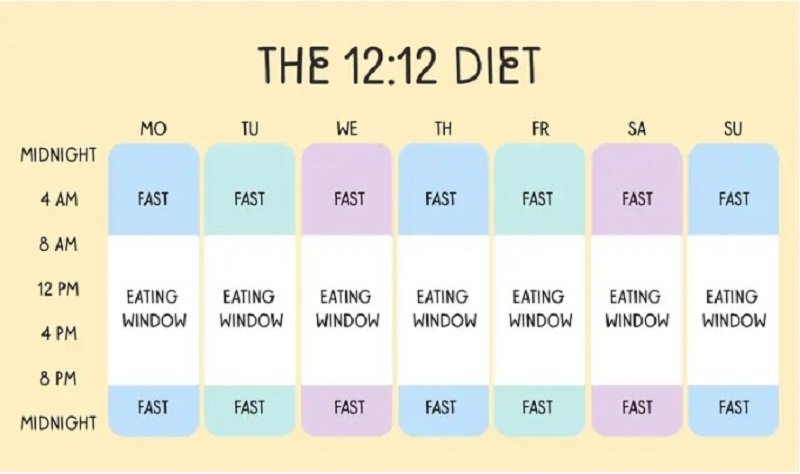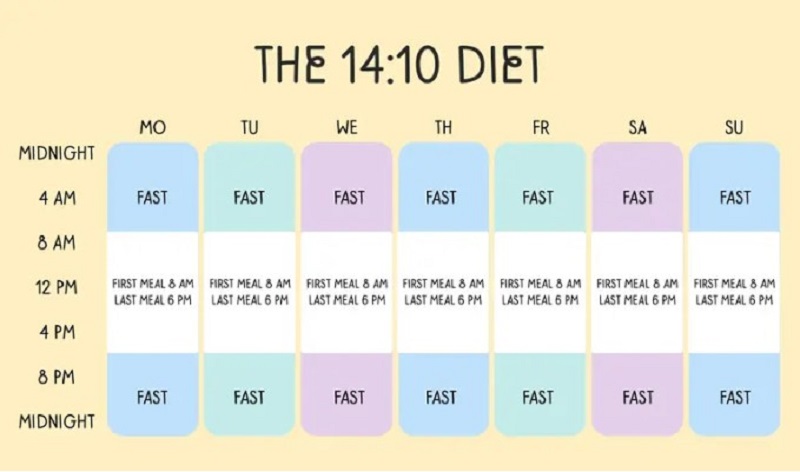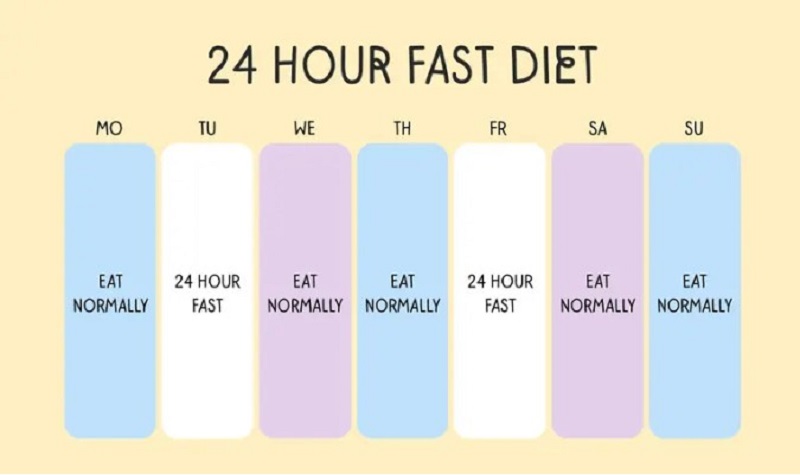Intermittent fasting for beginners is one of the simplest ways to improve health and manage weight naturally. This eating pattern focuses on when you eat, not what you eat. Many studies show it can support fat loss, boost energy, and improve metabolic health. Understanding the basics will help you decide if it is the right approach for your lifestyle. Let DuhoReview discover now!
What is Intermittent Fasting?

What is Intermittent Fasting?
Intermittent fasting for beginners can be defined as an eating pattern that alternates between periods of fasting and eating. Unlike traditional diets, it does not restrict specific foods but instead emphasizes the timing of meals. This method helps the body shift from using glucose to burning stored fat, making it a flexible yet powerful lifestyle strategy.
During fasting periods, the body initiates key metabolic changes such as improved insulin sensitivity and cellular repair. These biological shifts explain why many people report better energy and weight control when practicing intermittent fasting. Understanding how these processes work sets the stage for exploring the most common fasting methods.
How Does Intermittent Fasting Work?
The way intermittent fasting influences the body goes beyond simply skipping meals. It triggers complex biological processes that affect hormones, metabolism, and cellular repair. Let’s break it down step by step through the main mechanisms.
Hormonal Response During Fasting

Hormonal Response During Fasting
When you fast, insulin levels decrease, which allows the body to access stored fat more easily. Growth hormone (HGH) rises, supporting fat metabolism and muscle preservation. Together, these changes create an environment favorable for weight loss and energy balance.
For intermittent fasting for beginners, understanding hormones is crucial because they control fat storage and appetite. The drop in insulin also reduces the risk of insulin resistance and type 2 diabetes. These hormonal shifts are the foundation for many of the health benefits linked to fasting, leading into its impact on metabolism.
Metabolic Switching and Energy Use
After several hours without food, the body depletes glucose and switches to fat as its primary fuel. This process, known as metabolic switching, promotes efficient fat burning. It also encourages the production of ketones, which fuel the brain and other organs.
Intermittent fasting for beginners often feels challenging at first because the body is adapting to this new energy source. Over time, many people notice greater mental clarity and stable energy once ketone levels rise. This adaptation is key to why fasting can improve both weight management and overall vitality, preparing us to explore cellular repair.
Cellular Repair and Autophagy
During fasting, the body initiates autophagy, a process where cells clean out damaged proteins and waste. This repair mechanism reduces inflammation and supports longevity. It is one of the most important biological benefits of intermittent fasting.
For intermittent fasting for beginners, autophagy may sound complex, but it is simply the body’s way of recycling old cellular components. By activating this process, fasting helps prevent disease and promotes healthier aging. These cellular changes naturally connect to how genes also respond to fasting signals.
Gene Expression and Longevity Pathways
Fasting influences the expression of genes related to stress resistance and aging. Certain genes activate pathways that protect against chronic diseases and extend cellular lifespan. This genetic adaptation explains why fasting is often linked to longevity in research.
In the context of intermittent fasting for beginners, these genetic changes highlight why consistency matters. Regular fasting sessions allow the body to strengthen natural defenses at a molecular level. With these foundations in place, it becomes easier to understand why fasting is such a powerful tool for health before moving on to its specific benefits.
Popular Methods of Intermittent Fasting
There are several ways to practice intermittent fasting, and each method suits different lifestyles. Beginners are often advised to start simple before progressing to advanced styles. Let’s explore the most common intermittent fasting methods in detail.
The 12/12 Method – Easiest for Beginners

The 12/12 Method – Easiest for Beginners
The 12/12 method involves fasting for 12 hours and eating during the other 12 hours. It often includes overnight fasting, making it easy to follow without major lifestyle changes. This style is often recommended as the best intermittent fasting schedule for beginners.
For intermittent fasting for beginners, this method builds a solid foundation without overwhelming the body. It can help regulate appetite and reduce unnecessary late-night snacking. Once comfortable, many people transition from this approach to longer fasting windows like 14/10 or 16/8.
The 16/8 Method – Most Popular Plan
The 16/8 method, also known as time-restricted eating, means fasting for 16 hours and eating during an 8-hour window. People often skip breakfast and eat between noon and 8 p.m. This style is one of the most searched intermittent fasting plans for beginners.
Intermittent fasting for beginners 16/8 is effective because it naturally reduces calorie intake. Studies suggest this method improves insulin sensitivity and supports weight management. It’s often the first structured plan that helps beginners experience noticeable results.
The 14/10 Method – Gentle Transition

The 14/10 Method – Gentle Transition
The 14/10 approach is another form of time-restricted eating, where fasting lasts for 14 hours and eating is limited to 10 hours. Many women prefer this plan because it is easier to sustain while balancing hormones. It offers a gradual step up from the 12/12 pattern.
For intermittent fasting beginners, this plan reduces the feeling of restriction while still promoting fat burning. It is especially helpful for those who need a gentle introduction before attempting longer fasts. This flexibility makes it one of the most practical intermittent fasting schedules for everyday life.
The 5:2 Diet – Weekly Calorie Restriction
With the 5:2 diet, you eat normally five days a week and limit calories to 500–600 on two nonconsecutive days. This method allows flexibility while still creating a calorie deficit. It is popular for those who prefer not to fast daily.
For intermittent fasting for beginners, the 5:2 plan may feel challenging at first, but it can be effective for weight loss. Research shows it helps improve cholesterol levels and insulin response. Many find it easier to maintain compared to strict daily fasting.
Eat-Stop-Eat – 24-Hour Fasting

Eat-Stop-Eat – 24-Hour Fasting
Eat-Stop-Eat requires a full 24-hour fast once or twice per week. During fasting, only water, black coffee, or tea without calories are allowed. This approach demands discipline and is usually for more experienced fasters.
For beginners in intermittent fasting, trying a 24-hour fast should only come after mastering shorter methods. It can promote cellular repair and metabolic switching more deeply. However, it may cause fatigue, so medical guidance is often recommended.
Alternate-Day Fasting – Advanced Approach
Alternate-Day Fasting (ADF) means eating normally one day and consuming little or no calories the next day. This pattern has been shown to support weight loss and improve cardiometabolic health. However, it can be difficult to maintain long-term.
For intermittent fasting beginners, ADF is not usually the first option due to its intensity. Some find success with a modified version that allows 500 calories on fasting days. It is considered one of the most challenging intermittent fasting methods but also one of the most powerful.
The Warrior Diet and OMAD – Extreme Styles
The Warrior Diet involves eating very lightly during the day and having one large meal at night. OMAD (One Meal A Day) follows a similar principle, with a single eating window of about 1–2 hours. Both are extreme versions of intermittent fasting.
For intermittent fasting for beginners, these plans are not recommended as starting points. They can trigger binge eating or nutrient deficiencies if not carefully planned. Still, some advanced practitioners use them to maximize fat loss and test mental discipline.
Benefits of Intermittent Fasting

Benefits of Intermittent Fasting
Intermittent fasting is more than a trend; it has measurable effects on body weight and overall health. Scientific studies show both short-term and long-term improvements when fasting is practiced correctly. Below are the main health benefits explained in detail.
Weight Loss and Fat Reduction
One of the most common goals of intermittent fasting for beginners is weight loss. By shortening the eating window, most people naturally consume fewer calories. Combined with lower insulin levels, this makes stored fat more accessible.
Research on intermittent fasting weight loss results shows reductions of 1% to 13% of body weight depending on the method and duration. This calorie deficit occurs without strict food restrictions, making fasting sustainable for many. It highlights why IF is often considered one of the most effective dietary strategies.
Improved Insulin Sensitivity
Fasting reduces insulin resistance, which is a key factor in preventing type 2 diabetes. Lower insulin levels mean better blood sugar control and reduced risk of metabolic syndrome. These changes occur even in people who do not lose much weight.
For intermittent fasting for beginners, improved insulin response is a major health advantage. Studies confirm that fasting schedules like 16/8 and 5:2 can stabilize glucose levels. This benefit makes IF especially attractive for those with prediabetes or at high risk of diabetes.
Heart and Cardiovascular Health
Intermittent fasting may lower blood pressure, reduce LDL cholesterol, and improve triglyceride levels. These effects reduce the risk of cardiovascular disease over time. Research also shows increases in HDL cholesterol, the “good” cholesterol.
For beginners, adopting intermittent fasting can support long-term heart health without complex diets. Some intermittent fasting methods, such as time-restricted eating, show promising results in reducing waist circumference and visceral fat. These improvements demonstrate fasting’s potential as a tool for cardiometabolic wellness.
Brain Function and Cognitive Support
Animal studies and early human trials show that fasting increases levels of BDNF, a brain hormone that promotes nerve cell growth. This may improve memory, learning ability, and overall mental clarity. Many practitioners report better focus during fasting hours.
Intermittent fasting for beginners can enhance productivity by stabilizing blood sugar and reducing energy crashes. Ketones produced during fasting provide the brain with a steady fuel source. This benefit adds to the appeal of fasting as more than just a weight-loss method.
Reduced Inflammation and Cellular Repair
Fasting activates autophagy, the process by which cells clear out waste and repair themselves. This reduces oxidative stress and inflammation, two factors linked to chronic disease. These cellular benefits extend beyond short-term health improvements.
For intermittent fasting beginners, the idea of cellular repair may sound advanced, but it is simply the body’s way of renewing itself. Regular fasting has been linked to decreased markers of inflammation in scientific studies. This highlights its role in disease prevention and longevity.
Risks and Who Should Avoid It
While intermittent fasting for beginners can bring many benefits, it is not suitable for everyone. Certain health conditions and life stages require extra caution. Below are the main risks and groups of people who should avoid or limit fasting.
- Pregnant and breastfeeding women: Fasting during pregnancy or lactation may reduce essential nutrients needed for mother and child. Energy restriction can impact milk supply and overall fetal development. Experts recommend avoiding intermittent fasting for beginners who are in these life stages, especially when considering safe nutrition.
- Children and teenagers: Young people under 18 have higher energy requirements due to rapid growth. Restricting meals may interfere with healthy development and learning capacity. For this reason, most guidelines discourage intermittent fasting schedules for beginners who are still in adolescence.
- Individuals with type 1 diabetes: People with type 1 diabetes depend on insulin therapy to manage blood sugar. Fasting may cause hypoglycemia, leading to dizziness, fainting, or even severe complications. Those with type 2 diabetes should also consult doctors before trying intermittent fasting meal plans.
- People with a history of eating disorders: Intermittent fasting may trigger unhealthy behaviors like binge eating or food obsession. Those with anorexia, bulimia, or past disordered eating are at higher risk. For intermittent fasting beginners, mental health safety is as important as physical health.
- Women with hormonal imbalances: Some women may experience menstrual irregularities when calorie intake drops too low. Fasting can affect reproductive hormones and fertility if not managed carefully. Experts suggest easing into intermittent fasting for beginners 14/10 rather than jumping into longer fasts.
- Individuals with chronic illnesses: People with liver disease, kidney failure, or uncontrolled hypertension may face increased risks. Certain medications also require food intake to be effective and safe. Medical guidance is essential before starting any intermittent fasting plan for beginners.
These risks highlight why fasting should always be personalized rather than blindly followed. Knowing who should avoid it ensures safety and maximizes the health benefits of fasting. Next, we will explore how to get started with intermittent fasting tips and tricks to build a safe and effective routine.
Getting Started with Intermittent Fasting
For many people, beginning a new eating pattern can feel overwhelming. The good news is that intermittent fasting for beginners does not have to be complicated. By following a gradual approach, using a simple meal plan, and applying proven tips, you can build a sustainable routine.
How to Start Gradually: 12/12 → 14/10 → 16/8
The first step is learning how to adjust your eating window step by step. Each method helps the body adapt to fasting without unnecessary stress. Below are the three most common starting points:
- 12/12 Method: Fast for 12 hours overnight and eat during the remaining 12 hours. This is the easiest schedule for intermittent fasting beginners who want to control late-night snacking.
- 14/10 Method: Fast for 14 hours and eat within a 10-hour window. This gentle pattern is often suggested for women and those looking for an easy introduction.
- 16/8 Method: Fast for 16 hours and eat within an 8-hour window, usually from noon to 8 p.m. The 16/8 intermittent fasting plan for beginners is the most popular and highly effective for weight loss and improved insulin sensitivity.
Beginner-Friendly Meal Plan (7-Day Sample)
Once you know your fasting window, the next step is choosing the right foods. A structured meal plan helps you avoid overeating and supports stable energy levels. Here is a sample 7-day intermittent fasting meal plan for beginners:
- Day 1: Grilled chicken, quinoa, steamed vegetables, fresh berries.
- Day 2: Salmon fillet, leafy greens, avocado, sweet potato.
- Day 3: Lentil soup, mixed salad, whole-grain bread, apple.
- Day 4: Turkey breast, brown rice, broccoli, almonds.
- Day 5: Tofu stir-fry, mushrooms, bell peppers, pear.
- Day 6: Lean beef, spinach, olive oil dressing, banana.
- Day 7: Baked cod, cauliflower rice, asparagus, Greek yogurt.
Tips & Tricks
Finally, applying small strategies makes fasting easier and more effective. These tips are based on common intermittent fasting mistakes to avoid and proven best practices. Consider the following suggestions:
- Stay hydrated with water, herbal tea, or black coffee during fasting hours.
- Break your fast with nutrient-dense foods high in protein and fiber.
- Avoid overeating or choosing processed snacks during the eating window.
- Schedule workouts during or right after your eating window for better recovery.
- Track your progress in a journal to monitor mood, energy, and results.
- Be patient — intermittent fasting weight loss results take time.
- Consult a healthcare provider if you have chronic conditions or take medications.
By starting slowly, following a meal plan, and applying simple tips, intermittent fasting for beginners becomes much easier to sustain. Now that you understand how to begin, let’s look at how intermittent fasting affects special groups such as women, people with diabetes, and older adults.
Intermittent Fasting for Special Groups

Intermittent Fasting for Special Groups
Not everyone responds to fasting in the same way, and some groups require extra care. Intermittent fasting for beginners should always be personalized to fit health conditions and lifestyle needs. Let’s examine how fasting impacts women, people with metabolic issues, and older adults.
Women: Hormonal Impact, Menstrual Cycle, PCOS Benefits/Risks
For women, fasting can influence hormone balance and reproductive health. Some notice changes in the menstrual cycle when fasting windows are too long. Intermittent fasting for women should therefore start with gentle schedules like 12/12 or 14/10.
- Hormonal fluctuations may cause fatigue, mood changes, or irregular cycles.
- Intermittent fasting and PCOS research suggests it may reduce insulin resistance and improve symptoms, but results vary.
- Women who are pregnant, breastfeeding, or trying to conceive should avoid fasting without medical advice.
People with Overweight, Prediabetes, or Type 2 Diabetes
Intermittent fasting for beginners with metabolic concerns can offer powerful benefits. Research shows fasting improves insulin sensitivity and supports blood sugar control. Still, anyone with diabetes should consult a doctor before starting.
- Intermittent fasting and diabetes studies highlight reduced fasting glucose and improved HbA1c.
- Overweight individuals often see weight loss and lower blood pressure after adopting fasting schedules.
- Those using insulin or medication must be monitored closely to avoid hypoglycemia.
Older Adults: Special Considerations and Medical Guidance
For older adults, fasting may support fasting and longevity by promoting cellular repair and reducing inflammation. However, energy needs and muscle preservation become critical factors with age. Intermittent fasting for beginners in this group should always be guided by medical supervision.
- Seniors may require higher protein intake to protect muscle mass.
- Fasting windows should be moderate to avoid dizziness or nutrient deficiencies.
- Medical checkups are essential to adapt fasting safely to existing health conditions.
Each group faces unique benefits and risks, making personalization essential for safe and effective fasting. Now that we’ve looked at special populations, it’s time to answer the most frequently asked questions (FAQs) about intermittent fasting and clear up common doubts.
Frequently Asked Questions (FAQs)
Beginners often have similar concerns when starting fasting. To make intermittent fasting for beginners easier, here are clear answers to the most common questions.
Can I drink coffee or tea while fasting?
Yes, you can drink water, black coffee, and unsweetened tea during fasting hours. These drinks do not break the fast as long as they have no calories. Many intermittent fasting beginners find black coffee helpful in reducing hunger and improving focus.
Does intermittent fasting cause muscle loss?
Fasting does not necessarily lead to muscle loss when protein intake is sufficient. Growth hormone increases during fasting, which helps preserve lean mass. With strength training, intermittent fasting for beginners can support fat loss while maintaining muscle.
Can I exercise while intermittent fasting?
Yes, light cardio or strength training can be done while fasting. Some people prefer exercising during the eating window for better recovery. Intermittent fasting workout plans for beginners often recommend testing different times to see what feels best.
How long should beginners fast to see results?
Most people start with a 12/12 or 14/10 schedule and progress to 16/8. Noticeable results in weight and energy usually appear after 2–4 weeks. Choosing the best intermittent fasting schedule for beginners depends on personal goals and lifestyle.
Is intermittent fasting suitable for everyone?
No, certain groups such as pregnant women, children, and people with chronic illness should avoid fasting. Safety depends on health status, diet quality, and medical guidance. Intermittent fasting for beginners works best when adapted to individual needs and monitored carefully.
Conclusion
Intermittent fasting is a flexible lifestyle that supports weight management and long-term health. By starting gradually and choosing the right plan, anyone can make fasting sustainable. Consistency, nutrient-dense meals, and patience are the keys to success. If you are ready to take action, explore our recommended program and discover how simple it is to begin intermittent fasting for beginners.
Read more:
Energeia Reviews 2025: Does This Natural Fat-Burning Formula Really Work?
10 Alarming Effects of Sedentary Lifestyle and How to Avoid Them
